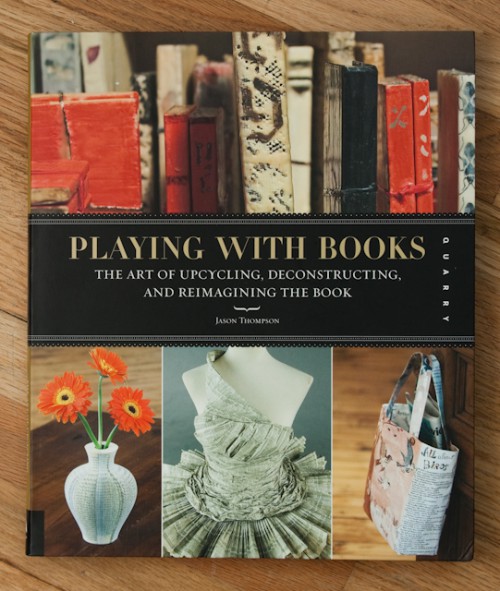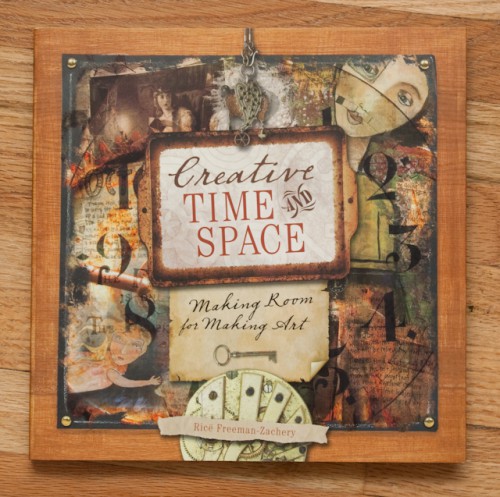A few months ago I was contacted by Ira and Oksana, two people in the Ukraine who write a book blog called Chytomo. They did an interview with me by email about my altered book works and this was translated into Ukrainian. It just recently went live on Chytomo so I thought I’d post the original English version here for people to read.

Chytomo: Can you tell us something about your first experience of altered book creation? Why did you begin to transform already published books?
RA: I started thinking about using books to create artwork in 2007, when I saw the work of Timothy Karpinski in Portland. He had painted his illustration onto the pages of old books, and I loved the idea. I was inspired and decided to apply the idea using photos, as my work at the time was primarily photography. This led to experimentation using inkjet image transfer paper to print my photographs within the pages of books. But the image transfer process didn’t mix well with the aged and brittle paper of book pages, so I left this idea on hold until I felt I had the right tools to create work in the way I envisioned.
In late 2007 I began to work in mixed media collage and spent the next two years developing a feel for techniques. My primary medium has always been film photography but as I worked more with a digital format I craved the satisfaction of creating work “hands-on”. In September 2009 I came across a wonderful book called, “New Directions in Altered Books” and suddenly my long neglected desire to work with books was reignited. It opened up a whole new world of artistic possibilities for me, and creating collage in three dimensions.
Chytomo: I haven’t noticed you to use the term “artbook”. I am right? Іs it because of another meaning of your artworks? what means “altered book”? (maybe, I have difficulties with translation? is it your own definition?)
RA: I use the term “altered book” because I take existing books and alter them to create my artwork, rather than making the book itself. It’s not my own definition.
Chytomo: The material for your artworks are the old books. And what the source of inspiration?
RA: There are two different ways I approach creating an altered book. Sometimes I want to experiment with a particular way of altering the book, for example a way of folding the pages or cutting into the book. Another source of inspiration are the objects or materials I have on hand. In the case of the few books I’ve created using wooden toy animals i was very much inspired to create an appropriate home for them.
Chytomo: And why such kind of material? Do you think the traditional kinds of materials have a limited abilities of expression? It seemed to have more social sense?
RA: I tend to use whatever I can find, either in stores or coming across items while wandering around outside. I am self-taught in these techniques so I don’t have any pre-conceived ideas of how I should be doing this or what materials I should be using. I think with collage pretty much anything can be used as a material.
Chytomo: What are the prefered techniques in this artwork?
RA: Because I’ve only been making altered books for about ten months I don’t yet have a preferred technique for how to approach making them. I try to experiment as much as possible because there are so many different things I can do to books.
Chytomo: How much does it take to create such kind of book and how many books had been already created?
RA: It takes me somewhere between 8 to 10 hours to create an altered book. The time varies depending upon what I’m trying to make. I have made nineteen altered books to date.
Chytomo: Is there any connection between the book content and further artwork?
RA: The content of the books I’ve chosen so far have nothing to do with the compositions I create within their pages. I try not to pay too much attention to what the book is about.
Chytomo: Do you have some favourite authors to work with?
RA: Not for making the altered books, but I do for reading. 🙂
Chytomo: Do you use only old books? Is it because the modern literature can’t inspire?
RA: Most of the books are old but this is more because older books were made with a stitched binding. Modern books are more often put together with a glued binding and this limits what I can do with the book because it’s more fragile.
Chytomo: Do you like to read? What are your favourite books?
RA: I do love to read. Some of my favorite books that I’ve read recently are, “The Time Traveler’s Wife”, “Animal, Vegetable, Miracle”, and “The Gargoyle”.
Chytomo: Is it your main job? Or it is just something like hobby?
RA: At the moment I am concentrating full-time on working as an artist. I was working for a web design company here in Vancouver, but decided to take a break from working for someone else to concentrate on my art.
Chytomo: What the average price of your altered book? Is it possible to order it from Ukraine? In what way?
RA: Some of the altered books are available online in my etsy shop. The average price is $500 USD.
Chytomo: Can you name anybody, who creates such kind of books and has a big “artbook name”?
RA: There are quite a few artists I’ve come across since I’ve started doing this who also work with books:
Brian Dettmer’s book autopsies, Georgia Russell slashes and cuts books, and Su Blackwell creates lovely dioramas in books.
Chytomo: Can you say something about Ukrainian books or artbooks?
RA: I’m not familiar with any Ukranian books or artbooks, but I’ve always admired Ukranian pattern design.
Many thanks to Ira and Oksana for interviewing me. I would love to do more interviews like this by email or in person, because it’s good practice for talking about my work. (This is a hint to let me know if you think of any such opportunities.)















































